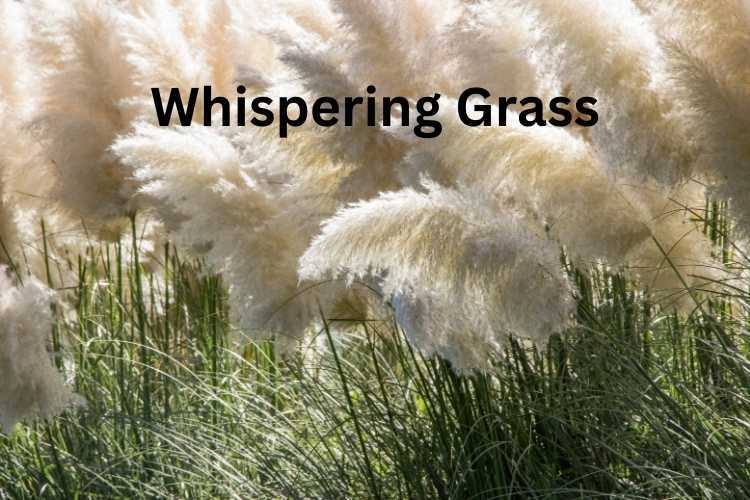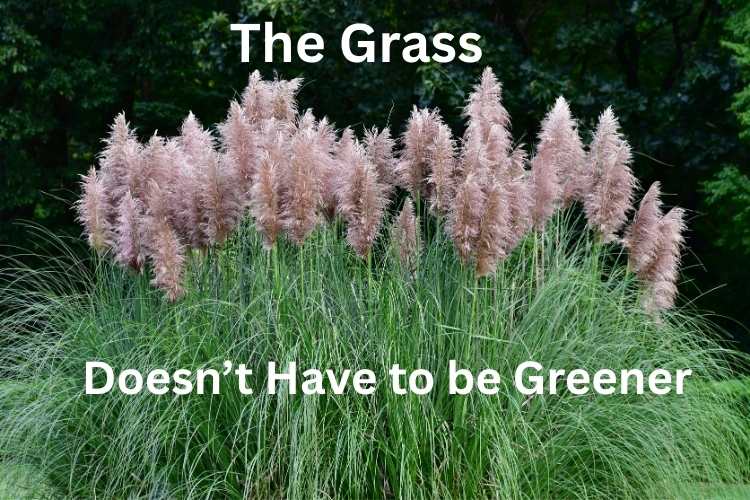Ornamental Grasses for Small Gardens
6th May 2025
Grasses are becoming more popular, not the lawn type, but ornamental grasses such as pampas grass. It’s easy to see why more gardeners are turning to these decorative grasses. They are colourful, graceful, and sculptural and add a special charm to outdoor spaces with their delicate textures and gentle movement – think of slender leaves and feathery plumes swaying in the breeze. They can be quite hypnotic. And, unlike many flowers that bloom briefly, ornamental grasses offer interest in every season, from their green growth in spring to golden hues and sculptural seed heads in autumn and winter.
And as if all that wasn’t enough ornamental grasses are also surprisingly easy to grow. In fact, one of the great advantages of these plants is their low-maintenance nature coupled with year-round appeal. This makes them a fantastic addition to any garden, large or small. But, in this article, we’ll concentrate on how you can plan, plant, and grow ornamental grasses in small gardens.
They are a great addition to your planting schemes as they bring a natural, informal beauty that softens the hard edges of walls and buildings and adds life to patios, courtyards, and little outdoor spaces. Even in the smallest garden, well-placed grasses can catch the light, rustle softly in the wind, and create a nice soothing atmosphere - especially on a patio or seating area. Garden designers often use ornamental grasses to add structure to their gardens as many varieties stand upright and can grow quite tall.
Yet unlike some bulky types of shrubs, ornamental grasses have a narrow footprint and can be kept fairly compact so they won’t crowd a smaller space. With so many sizes and shapes available – from knee-high tufts to taller, slender clumps – it's easy to find ornamental grasses that will add a touch of elegance to your garden without overwhelming a limited area.
The Appeal of Ornamental Grasses
So, what is it about ornamental grasses that makes them so attractive to gardeners? Well, as we’ve already touched upon it’s probably down to a unique combination of movement, texture, and seasonal interest:

Movement
The old song ‘Whispering Grass’ sums this up. The slightest breeze creates gentle motion in the grass and even a calming rustling sound. It really is the plant’s most endearing quality. This movement brings a garden to life, especially in the stillness of a small space. Even a slight wind will set the grass plumes swaying, adding a dynamic element that static shrubs or flowers just can’t match and is really effective in a small garden.
Texture
Grasses are very textural. Their foliage can be feathery, silky, or spiky, and they look very different but provide a nice contrast to flowering shrubs and broadleaf plants. For example, fine grass blades next to larger leaves (like hostas or hydrangeas) create a pleasing mix. Grasses also often have showy plumes or seed heads that rise above the foliage and soften the overall garden look. In design terms, this texture can soften the hard surfaces in a garden, softening the edges of paths, patios, or walls.
Seasonal Interest
There are many ornamental plants and trees that peak in one season, but in comparison grasses offer something in spring, summer, autumn, and even winter. In spring and summer, they are lush and green (some even have streaks of colour or variegation). By late summer, many grasses put out beautiful plumes or flower spikes. Come autumn, their foliage often changes tone – think golden yellows, coppery oranges, or deep burgundy hues – and the seed heads mature, sometimes lasting well into winter. In the low winter sunlight many grasses can be left standing, providing structure and interest against frost or snow. This means one grass can deliver visual interest in a small garden even in the drab months.
Colour and Sound
While grasses aren’t known for bright flowers, some do have foliage that is coloured (blue-grey, purple, red-tinted, etc.). While not in the class of a blooming rose, ornamental grasses can add subtle colour to the garden. Also, the combination can produce a soft whispering sound as the blades and seed heads rub together. This brings an almost Zen-like quality to your garden. If you have a sensory garden you really should consider planting an ornamental grass or two.
In short, ornamental grasses bring a natural elegance to gardens. Their versatility and charm make them not just background plants but real features in their own right.

Why Ornamental Grasses Suit Small Gardens
At first thought ornamental grasses and small gardens don’t appear to be the best bedfellows. After all, grasses can become very overpowering so can they really work in a small garden? The answer is absolutely yes. Ornamental grasses are actually a fantastic choice for small gardens, for several reasons:
Vertical Structure
Many ornamental grasses grow upright or in neat clumps, which means they add height without taking up much ground space. And even if they do spread a lot you can cut them back to keep them in control and manageable. In a small garden, you can use taller grass as a vertical accent or focal point (much like a small tree or shrub) to draw the eye upward without crowding the plants around it. For example, a grass that grows to a few feet tall but only a couple of feet wide will look great in a narrow bed or corner. This is a smart way to introduce structure to a compact garden design. In fact your ornamental grasses may even end up as the stars of the show. But what should be emphasised is that you don’t need acres of room for your grass to have a real impact in your garden.
Diverse Sizes for Any Spot
Ornamental grasses come in a huge range of sizes and forms, so it’s easy to choose one that fits your space. Just read the product descriptions on the web page or on the plant label to ensure you’re buying the right grass for your garden. There are towering varieties that might be too large for a small garden, but also plenty of compact plants that stay small. So, if you have a small garden or patio, you might choose a small grass that only grows 30–60 cm tall to edge a flowerbed or fill a planter. For slightly larger small gardens, mid-sized grasses can create fullness without overwhelming. The key is that you can choose a more compact grass and it will still add a touch of elegance no matter how small the space. This flexibility means any small garden can find a grass that fits.
Variety Without Clutter
For maximum effect in a small area you need variety in the type, colour, and scale of plants without overpowering or cluttering the space. You need a variety to avoid a boring look – but too many different plants can feel cluttered. Grasses strike a great balance. The unique look and texture is very different from typical shrubs or perennials, so adding even a couple of grasses instantly provides variety. At the same time, their neutral colours (greens, tans, etc.) and fine textures help them mingle well with other plants rather than clashing. You can tuck a few grasses among flowering plants to break up the monotony of all blooms. Designers often use grasses to define a set space or border within a garden with their forms. In a small garden, they can pick out a little border or create a gentle partition without the need for hedges or fences.
Low Maintenance, High Reward
For gardeners with limited space (and often limited time), ornamental grasses are ideal because they don’t demand coddling. They tend to be tough, resilient plants that handle a variety of conditions. Many are drought-tolerant once established, and most have few pests or diseases to worry about (no constant spraying or fussing required). Unlike high-maintenance roses or perennials, grasses generally don’t need frequent feeding or pruning – just an annual cut-back (more on that in the care section). As one expert puts it, ornamental grasses “are low-maintenance, resilient, drought tolerant, have few pests, and provide good wildlife habitat”. In a small garden, where each plant needs to pull its weight, this reliability is golden. You can plant a grass, keep it watered until it settles in, and then largely enjoy it without much effort. This is especially appealing for urban gardeners or anyone who wants a beautiful garden without a huge time investment.
Year-Round Presence
Small gardens can sometimes lack year-round interest – for instance, if you rely only on summer flowers, the garden will look and feel a little barren in winter. Ornamental grasses overcome this issue because there is always something happening no matter the season. Many hold their form through autumn and part of winter, meaning your tiny garden still has attractive structure in the off-season. And in spring, many grasses start growing early and quickly fill out, so you aren’t left with empty gaps in your borders or plant beds for long.
Wildlife Friendly
Even in a small garden, you can do your bit for the environment and even the local wildlife. Birds may visit to eat the seeds or use strands of grass for nesting material, and some insects may even hide in the foliage. Songbirds and pollinators can find food in your ornamental grass and you may even see butterflies flit through the cover that grasses create.
Preventing Grasses from Overwhelming Your Garden
While ornamental grasses can be stars in small gardens, without a bit of planning they could overwhelm a space or look out of proportion. But fear not, here’s a few tips on how make sure that doesn’t happen.
Choose the Right Size (Scale is Everything)
We mentioned this earlier but needless to say it’s very important that you only choose ornamental grasses that naturally grow to a size that suits your space. It’s always tempting to plant that gorgeous tall grass you saw online, but first check its ultimate height and width. It might be obvious but always choose smaller or mid-sized varieties for small gardens – many ornamental grasses have dwarf cultivars or naturally compact species. As a rule of thumb, try not to plant anything that will regularly exceed the height of your fence or the scale of your other plants, unless you specifically want one tall specimen.
Remember that a grass labelled “90 cm tall” might have flower plumes that reach 120 cm at peak. Also consider width: a grass advertised as forming a 60 cm clump will eventually form that diameter – does your garden have the room to cope with that growth?
If you really want a taller grass, make it a focal point and give it pride of place (and ensure it won’t cast too much shade on every other plant).
To sum up, ornamental grasses bring structure, beauty, and easy-care toughness and look fantastic in small gardens. They offer the best of both worlds: the visual impact of larger plants, but are very manageable for a small space. Ready to add them to your garden? Explore the full range of ornamental grasses at Direct Plants.


